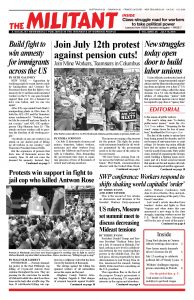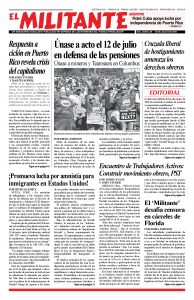NEW YORK — Opposition by working people to recent factory raids by Immigration and Customs Enforcement shows that the fight to win amnesty for 11 million undocumented workers in the U.S. can gain broader support than ever. It’s a demand we have won before, and we can win again!
After ICE cops raided Fresh Mark’s meatpacking plants in Ohio June 19, both the AFL-CIO and the Teamsters union condemned it. “Seeking a better life for yourself and your family is not a crime,” said AFL-CIO spokesperson Chip Shannon June 29. “The attacks on these workers call to question the freedom of all working people.”
“An attack on any one worker is an attack on our shared goal of lifting up all workers in our country,” said Teamsters President James Hoffa.
But the organizers of protests that drew tens of thousands across the country June 30 did not raise the demand for amnesty. Instead, they focused on denouncing the Donald Trump administration’s policy of separating children from their parents detained near the southern border, a policy that had already been reversed. They chose to make the “Resistance” against Trump the all-consuming issue.
The government recently announced a “zero tolerance” policy, and began prosecuting “unauthorized” immigrants for first-time illegal entry — a misdemeanor.
Under the administration of Barack Obama, most first-time “offenders” were issued “forcible removal” orders and summarily deported. Prosecution and jail time prior to deportation was reserved for those charged with illegal “re-entry,” which became a felony when President Bill Clinton signed the 1996 Illegal Immigration Reform and Immigrant Responsibility Act.
The June 30 actions also protested the Supreme Court’s 5-4 ruling upholding President Trump’s executive order limiting entry to the U.S. from seven countries — Iran, Libya, North Korea Somalia, Syria, Venezuela and Yemen. The governments of these countries, the administration says, do not cooperate with U.S. anti-terrorism screening.
The main goal of protest organizers was to use outrage over the children’s treatment to get out the vote to defeat the Republicans and elect Democrats to office in November. They portrayed immigrants as helpless victims, as opposed to fellow fighters whose presence here strengthens the working class and its capacity to stand up to the bosses.
Bosses need immigrant labor today
The capitalists depend on immigrants to maintain a superexploited layer of the working class, push down the wages of U.S.-born workers and compete with their rivals. This is certainly true today, when an uptick in markets, production and trade has pressed them to look for more workers. The rulers use the threat of deportations to try to keep undocumented workers in line. They scapegoat immigrants to divide the working class and weaken its ability to unite and fight against boss attacks on wages and working conditions for all workers.
If you look at a chart showing the yearly numbers of deportations since the 1950s, you wouldn’t be able to tell if a Democrat or Republican was in the White House. The U.S. rulers promote or restrict legal and “illegal” immigration based on their need for workers.
It was Republican President Ronald Reagan who yielded to pressure and granted amnesty to nearly 3 million people in 1986. And it was George H.W. Bush who presided over amnesty for another 1.5 million in 1990.
It was Democratic President Clinton who oversaw the highest number of deportations in a single year — 1.8 million his last year in office. And it was Obama who prosecuted and jailed more people for immigration violations than any other president in history. Trump’s immigration “enforcement” is a continuation of the rulers’ divide-and-rule strategy.
‘Abolish ICE’ is a diversion
Organizers of the June 30 actions raised the demand “abolish ICE,” which sounds very radical, but is in fact a sham. Despite the rhetoric, they’re not calling for dismantling the immigration police, but for “restructuring” them into something impossible — a kinder, gentler deportation police.
This has happened before. ICE was set up to replace the hated Immigration and Naturalization Service in 2003. But Latino workers have called both “la migra,” and looked for allies to fight for the right to remain and work in the U.S.
Less anti-immigrant sentiment
There is less racism and anti-immigrant sentiment among working people today than ever. A good example is what happened in Morristown, Tennessee, after immigration cops raided the nearby Southeastern Provision meat-processing plant April 5, arresting 97 workers.
This is an area that voted 77 percent for Trump in the presidential elections. The raid and others like it have sparked a debate, with hundreds meeting and marching in solidarity with immigrant workers.
In last week’s issue we reported on a march of a few hundred through Morristown April 12 to protest the raid. There was also a meeting of nearly 1,000 people at the local elementary school auditorium April 9 that drew large numbers of U.S.-born residents who came to show solidarity with those threatened with deportation. The week before 120 schoolteachers met to discuss what they could do to help students whose relatives had been picked up. Local churches had so many offers to help they turned away some volunteers.
The longer native-born workers and those without government-approved papers live and work side by side, the more they join together to protest deportations.
“This is going to hurt so many people in the community. It’s going to hurt their kids, our kids,” 42-year-old Angela Smith, a longtime resident of the Morristown area, told the New York Times after the raid. “It’s going to have a ripple effect throughout the entire community because these people are part of Morristown. Immediately I drive over to the parish center to see what I can do to help. I had to park way at the end because it was so packed.”
Fighting for amnesty can mobilize broad sections of the working class — from the unions and working-class neighborhoods of all kinds — in a sustained struggle we can win. And it’s part of organizing the unorganized and rebuilding a militant, fighting labor movement.

